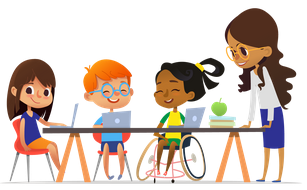Check out our:
Special Education Initial Referral Timeline
Special Education Full and Individual Initial Evaluation Timeline

What does “child with a disability” mean?
The term "child with a disability" means a child with intellectual disability, hearing impairments (including deafness), speech or language impairments, visual impairments (including blindness), serious emotional disturbance (referred to as "emotional disturbance"), orthopedic impairments, autism, traumatic brain injury, other health impairments, or specific learning disabilities; and who, by reason thereof, needs special education and related services (34 CFR§ 300.8).
What is Child Find?
Child Find is a component of the Individuals with Disabilities Education Improvement Act (IDEA) 2004 that requires States and Local Education Agencies (school districts and charter schools) to identify, locate, and evaluate all children with disabilities residing in the State, regardless of the severity of their disabilities, and who are in need of special education and related services (34 CFR§ 300.111). Child Find is a continuous process of public awareness activities, screening and evaluation designed to locate, identify, and evaluate children with disabilities who are in need of Early Childhood Intervention (ECI) Programs (Part C) or Special Education and Related Services (Part B).
What happens if the student continues to struggle even with general education supports?
The parent(s) or legal guardian will be contacted by the local school district. The child may be referred for a full individual evaluation (FIE) to help determine eligibility for special education and related services. Parents/guardians and the school will decide if an evaluation is needed. The same group may develop an evaluation plan designed to assess areas of concern. If appropriate, an evaluation will be conducted by qualified school district/agency personnel. The parents and evaluation personnel will have a meeting to talk about evaluation results and eligibility for special education and related services.
What services may be available through special education?
Each child’s individual need(s) will be addressed on an individualized basis by a team consisting of: public agency representative, parent(s) or guardian, a person who can interpret evaluation, teacher(s), and the student (if appropriate). The team will review evaluation information, discuss eligibility, identify area(s) of need for specialized instruction, including related services (such as occupational therapy, physical therapy, or counseling) and develop a plan to fit the needs of the child.
Who do I contact?
If you are concerned about a child’s learning, contact your local school campus, district, or charter school. If you need help contacting your local school campus, district, or charter school, contact SPEDTex at 1-855-773-3839.
How much do services cost?
All services provided by Local Education Agencies (school districts and charter schools) through IDEA 2004 (Part B) Special Education and Related Services (Part B) are at no cost to the individual or parents.
Who can begin the Child Find process?
Anyone can start the process: a parent/guardian, doctor, teacher, relative or friend can call their local school district Child Find. If you are concerned about a child’s learning, contact your local school campus, district, or charter school.
What do I do if I know of an infant, child, or adolescent who does not learn easily?
All individuals develop at their own pace but some have more difficulty than others. Early identification and intervention can prevent failure and frustration. Special attention to teaching and learning strategies may help individuals overcome barriers to learning. Often these strategies can be provided through general education programs. The Child Find Framework of the Legal Framework for the Child Centered Process (www.esc18.net ) provides additional information and outlines mandates.
Under the No Child Left Behind Act (NCLB), 2001, each LEA must have a district improvement plan developed to guide district and campus staff in the improvement of student performance for all student groups in order to attain state standards. The district improvement plan must include strategies for improvement of student performance such as: instructional methods designed based on the needs of student groups not achieving; processes for addressing the needs of children in special programs; integration of technology in instructional and administrative programs; positive behavior supports; staff development for educators; and accelerated instruction.
 Program Coordinator
Program Coordinator Consultant
Consultant Consultant
Consultant Administrative Assistant
Administrative Assistant